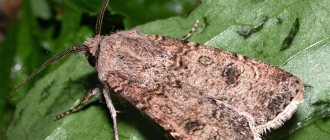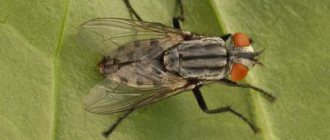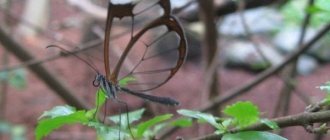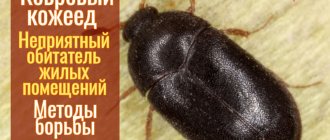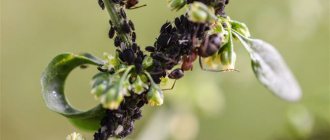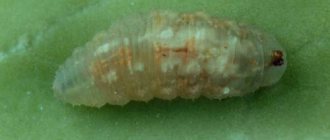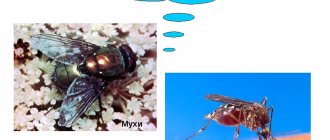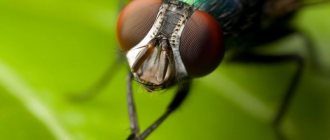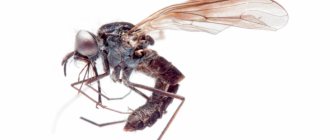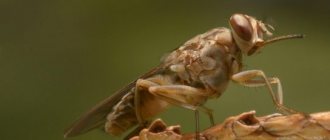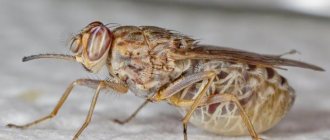Plant protection products
Order: Diptera. Family: cereal flies. Alternative title:
Oscinella frit, O. pusilla.
The Swedish fly is a well-known crop pest that damages corn, barley, rye, oats, spring and winter wheat. There are several types of Swedish flies, which differ in their diet. The most famous are the Swedish oat fly and the Swedish barley fly. In areas where grain crops are grown, the Swedish fly is ubiquitous.
Methods to combat Swedish fly
Recently, the phytosanitary situation in the wheat fields of Kazakhstan has been deteriorating due to frequent violations of cultivation technology, lack of protective measures, and non-compliance with requirements for the use of fertilizers and chemicals. This provokes the appearance of the Swedish fly in large quantities.
One of the main methods of combating it is complex chemical treatment against pests and weeds. When spring wheat begins to bush, the Swedish fly appears on it. At the same time, many weeds appear in the fields. Therefore, complex processing helps solve two problems at the same time.
One of the best chemical preparations that has proven its effectiveness in controlling pests on winter crops is the contact-system insecticide Borey, designed to combat a complex of pests, including latent ones. There are other insecticides on the market that are widely used on farms, for example, Dexter, Tabu, etc.
What kind of pest is this
The Swedish fly is a member of the family of cereal flies Chloropidae (order Diptera) . It was first described in Sweden by the first taxonomist Carl Linnaeus (1756). About 30 species of this insect are now known.
What does it look like
The adult has an elongated body measuring 1.5-2.5 mm and black in color . The female's abdomen is thicker and ends with a narrow ovipositor. The scutellum is rounded, the dorsum is slightly convex and smooth.
The wings are small transparent with a metallic sheen. On the head there is a small proboscis and black antennae.
Why is it dangerous for winter wheat?
The Swedish fly causes the main damage to winter wheat in the fall . Emerging at the end of September, the females lay eggs in the leaf axils of young shoots during the period when the second leaf emerges. Then egg laying stops and usually stops after 50% of the third leaf has reached.
The hatched voracious larvae, which are twice the size of an adult, penetrate the shoots at the base of the stem. There they eat upward, reaching the ear bud, and eat it and the milk grains.
If the Swedish fly larvae damage the main stem, the crop dies , which is why the yield percentage is significantly reduced - by 50%.
Reference! Swedish fly larvae damage about 20 species of cultivated and 46 species of wild cereals.
Reproduction and life cycle
Pests reproduce so quickly that in one season they manage to produce up to 5 generations of individuals if the weather is favorable. The female carefully chooses a suitable place. First, it checks all the stems, stroking them with its antennae, and then lays eggs in cereal plants that have reached a certain stage of the growing season. The size of the eggs is 0.7-0.8 mm.
The larvae develop within the egg for approximately eight days , then emerge in search of food. With the help of special salivary glands that secrete a specific enzyme for the breakdown of plant tissue, the rudiments of future wheat grains are absorbed.
In nature, the life cycle of larvae is about a month with sufficient nutrition, in laboratory conditions - up to 40 days. They can survive without food for a maximum of seven days.
The insect spends the winter hibernating as a pupa in the stubble of perennial cereals and on the seedlings of winter crops. Activates with the arrival of spring at temperatures above +12°C.
It can be useful:
Wheat pests and diseases, photos and descriptions
Why is wheat smut dangerous and how to deal with it?
Preventive measures
To obtain a high yield, preventive measures are necessary:
- Timely peeling of stubble to destroy the pest and its larvae.
- Sowing with high-grade calibrated seeds. They produce friendly and strong shoots, and these are more resistant to the attacks of the Swedish fly.
- Treating grains before sowing into the soil. The drugs “Gaucho” and “Cruiser” are used.
- crops with grain crops after legumes or row crops.
Large grain aphid Sitobion avenae F.
The body is 2.5-3 mm long, yellowish-green in color with long legs; antennae longer than body. Winged females have a blackish-brown chest and a green abdomen. The larva is imago-like.
1. Order Homoptera
3. Distribution everywhere, cereals
4. Egg overwintering phase
5. Wintering place on the leaves of winter seedlings, on carrion and wild cereals
6. Developmental biology The larvae hatching in May transform into wingless female founders. During the growing season, they reproduce parthenogenetically, that is, without the participation of males and without fertilization, they give birth to larvae (viviparity) without laying eggs. When nutritional conditions deteriorate (approximately in the 3rd generation, 2nd ten days of May), winged female dispersers appear, which fly to less hardened spring grains. In August, female stripers appear. In September, they give birth to males and females in winter crops, which after mating lay 2-4 eggs, up to 12 (for the winter). Aphids reach their greatest numbers and harmfulness during the heading period - milky ripeness.
7. Number of generations 10-12
8. Harmful phase of larva and imago
9. The nature of the damage caused is by sucking the juices out of the leaves and stems. Leaves become discolored, turn yellow and die. They colonize green ears and suck out the juice of their various parts (the weight of the grain decreases). When plants are planted before heading, they do not head. Virus carriers.
10. EPV: 5-10 aphids / 1 stem (ear) and colonization of more than 50% of plants (exit into the tube - heading), 20-30 aphids / 1 ear (filling grain)
11. Natural enemies are beetles and larvae of ladybirds, larvae of lacewings and hoverflies
12. Control measures – stubble peeling, fall plowing; – early sowing of spring and early ripening varieties; -use of fertilizers (phosphorus) that accelerate and enhance development
– spatial isolation of winter crops from spring crops
– when the EPV is exceeded in the phases of exiting the tube – heading and grain filling, the following preparations are used: fastak 0.1 l/ha, decis-extra 0.05 l/ha, actellik 1 l/ha, karate 0.2 l/ha, Bi -58 New 1-1.2 l/ha, senpai 0.2 l/ha
Appearance of an insect
Larva
The larvae grow up to 4.5 mm long; their body is oblong and cylindrical, delimited into 13 segments.
There are no paws; instead, there are small spines on the body that are responsible for movement. The head is not clearly distinguished; it can only be traced by fan-shaped spiracles of six translucent tubes, short antennae and crescent-shaped oral hooks.
During the period of maturation, the larva changes color from milky transparency to a bright lemon color.
Adult fly
An adult fly is half the size of a larva, its size rarely exceeds two millimeters, and differs from other flies by its neat rounded head, small proboscis and smooth back.
The color easily attracts attention: the shiny black body emphasizes the green metallic tint of the wings, contrasting with the pale lemon coloring of the legs and abdomen.
Cabbage whites can cause great harm to cabbage, so it is very important to take timely measures to combat this insect. Cabbage fly larvae appear after 10-15 days. You can find out more information about the insect here.
The Italian locust, or Italian locust, can seriously damage the crop - sometimes losses reach up to 80%. Find out how to control this pest at this link.
How to deal with wheat pests
Measures to combat the listed pests and preventive procedures are carried out approximately the same and include:
- Agrotechnical measures : stubble peeling and deep fall plowing, compliance with crop rotation and sowing dates, growing resistant varieties.
- Chemical : spraying grain with approved types of insecticides, for example, “Karate”, “Arrivo”, “Fastak”, “Aktelik”.
- Preventative : before storing in storage, treat grain with agents based on carbendazim, mancozeb, triticonazole. And also maximum drying of the product, thorough cleaning of the room, disinfection of the storage, for example, with formaldehyde vapor (after this, the storage is kept hermetically sealed for 2-3 days, then thoroughly ventilated).
Morphology
Imago . The fly is 1.5–2.5 mm long.[6] Color black. The base of the abdomen is yellow below, the legs are black with yellow paws. The height of the cheeks at the narrowest point is less than the length of the third antennal segment, but greater than the diameter of the tibia at the apex. The ratio of the lengths of the II and III segments of the arista is 0.52 – 0.57. The wings are transparent.[2]
Sexual dimorphism . Individuals of different sexes differ in the structure of the genital organs. The structure of the genitalia of males and females is used to accurately determine the species.[1]
Egg 0.7 – 0.16 mm. The shape is elongated cylindrical. Color white or cream.
The larva consists of 13 clearly distinguishable segments. The color of the completed larvae is whitish-yellow, the body shape is cylindrical. The body is pointed in front, rounded behind. On the anal segment there are two fleshy rounded tubercles with spiracles having three spiracular slits. On the cuticle of each segment the main row of spines is absent, in contrast to the larva of the Swedish barley fly (Oscinella pusilla). Sometimes remains of spines are observed in the form of one or two stripes at the edges of the ridge. The closing zone is formed by one or two stripes of small spines. Length 3 – 4 mm.[2]
Doll . Puparium length 1.75 – 3 mm, width 0.8 – 1.3 mm. Cylindrical shape, brown color. There are four teeth in the anterior part and two processes at the posterior end.[6]
| Phenology of development (in days) | |
| Transformation | Complete |
| Full cycle | 22 – 46 |
| Egg (embryo) | 5 – 38 |
| Larva | 20 – 28 |
Maliciousness
The greatest danger to cereals is the larvae of the Swedish fly, which eats away the cone of the cereal and all adjacent tissues, which leads to the death of the central leaves and, accordingly, to a slowdown in growth or death of the entire plant.
Damaged specimens are distinguished by dark greenery and thickening of the stem - the trunk thus tries to compensate for the affected internal tissues. Productivity decreases, as the larvae gnaw out milk grains, preventing them from ripening.
The total amount of losses consists of many factors:
- aridity;
- plant nutrition conditions (the better they feed, the higher the likelihood of survival);
- delayed tillering (plants with several lateral stems will easily tolerate infection);
- air temperature (at minus 10, flies stop laying eggs and hibernate);
- choice by a fly to lay eggs on lateral or central stems.
Stages of development
Most insects are characterized by developmental metamorphosis in several stages. The fly is no exception. In the life of this insect, all the traditional four stages are present, during which this pest goes through its entire life path.
So, let's list these 4 phases of life and development of a fly, they are as follows:
- egg;
- larva;
- chrysalis;
- adult.
Now let's go through each of these four stages in more detail. Let's find out how long it takes an insect to pass through each of them, and how they are characteristic.
Egg
As already mentioned, one female fly can lay up to 120 eggs at a time. Usually, for laying, these insects choose the places most suitable for the survival of their offspring in the first stage of life.
These include:
- all kinds of human waste;
- cattle manure and domestic animal excrement;
- corpses of dead animals;
- cesspools;
- rotten fruits and vegetables;
- rotten meat products.
During this one day, fly eggs that do not exceed 2 mm. in length, nourish the embryos located inside with yolk. After which, about 24 hours later, larvae emerge from the eggs.
Larva
Like a fly walking on the ceiling.
The larvae that have just hatched from the eggs resemble thin white threads that can barely be seen with the naked eye. When asked how long it takes for the larva to move to the next stage of development, let’s say that the insect usually stays in this state for about a week, more often not even more than 5 days.
The larva is usually very difficult to detect, since it avoids exposure to direct sunlight and tries to burrow as deeply as possible into the environment in which it was born. In the thickness of the nutritional substance, the larva gains the calories it needs for development.
It becomes fatter, becomes larger, changes its pale color to a brownish tint, after which it pupates, making the transition to a new stage of its existence.
Doll
The most passive stage of an insect's life is the stage of being in the form of a pupa. A fly pupa is formed by hardening the skin of the larva, which becomes the pupal case or puparium. Inside this case, the final metamorphosis occurs, during which the tissues of the larva disintegrate and a restructuring of all its systems occurs.
This is how the adult individual (imago) is formed, so familiar and easily recognized by everyone. How long does this transformation process take? Just 5 days, and another buzzing pest is born in all its “glory.”
Rice weevil
Rice weevil photo
Widely distributed, most common. Sometimes in individual batches the infection density reaches several tens of specimens per 1 kg of grain. you. The frequency of occurrence of the beetle increases as you approach the southern regions of the country.
The beetle is 2-2.8 mm long. Body color from brown to brown-black, matte; there are two reddish spots on the elytra. Rice weevil beetles have a well-developed second pair of wings and can fly. Therefore, they are able to move from granaries and infect grain in the field.
The egg is 0.6-0.7 mm long, 0.28-0.29 mm wide, oval or pear-shaped, grayish-white. The larva is 2.5-3 mm yellowish-white, legless. Pupa 3.7-5mm, yellow-white.
Khat reproduces: granary weevil, lays eggs in grain one at a time, and in total the female can lay more than 500 eggs. embryonic development lasts 4-6 days, the larva develops 25-30 days, the pupa 5-8 days. Beetles live from 3 to 8 months. The development of one generation lasts at a temperature of 15-20-25-30ºС, respectively 309-71-40-28 days. The lower temperature threshold for development is 13.5ºС, the optimal temperature is 27-29ºС, air humidity is 70%. At temperatures of 35°C and above, the rice weevil does not develop. The pest produces 3-4 generations during the year in the central regions, and 7-6 in the south. The rice weevil is more polyphagous than the granary weevil. Damages grain of various crops, cereals, pasta. Wheat and rye grains, in which larvae and beetles developed, lose from 35 to 75% of their weight. Signs of grain damage are similar to those of barn weevil.
